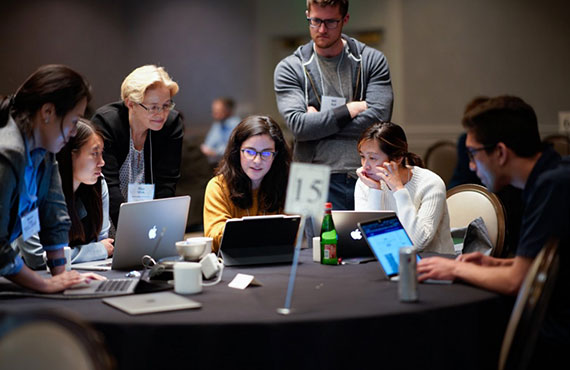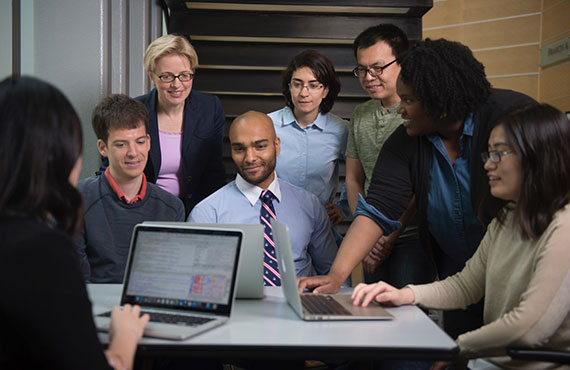This professor rarely works alone: ‘The total is more than the sum of its parts.’
Author: Sarah Coppola
Date: 12.15.20

Photo: Liz Linder Photography
Professor Olga Vitek remembers her first job as a young graduate student, working as a data analyst in the lab of a Swiss hospital. “I was doing analysis related to nutrition, and the conclusions were something very unexciting, like, ‘In Italy, they eat more carrots than in Spain.’”
She realized she didn’t have the temperament to toil away in a lab alone—and wanted her research to have a more meaningful impact on public health. “I wanted to do something where I could poke at questions in different ways and get to the ground truth of evidence,” she says.
Fast forward 20 years to today: Vitek uses computer software to study the innumerable proteins that serve as the building blocks of human life.
She and her research collaborators, including Khoury graduate students and life scientists worldwide, look for evidence of molecular changes to better understand how diseases unfold, in order to more effectively attack and defeat them in the future. The information can be hard to decipher, like straining to hear a quiet voice in a noisy restaurant. So Vitek, a data scientist, develops sophisticated tools and algorithms to more easily and precisely analyze proteins.
“The data leaves traces of what’s happening, and you need to put the clues together,” she says. “It’s a little bit of anticipation and speculation. It’s a little bit like Sherlock Holmes.”

Vitek at Chan Zuckerberg Initiative’s event for Essential Software for Science (EOSS) program. Photo courtesy of CZI, 2020.
Because Vitek’s research in computational biology touches on so many scientific fields—machine learning, artificial intelligence, biology, and chemistry, to name a few—she almost never works alone. Trained in several specialties herself, she encourages students to work actively with doctors, researchers, and industry partners. For instance, biotech firms like Genentech and Hoffman-La Roche provided Vitek’s lab with molecular data; she and her team used the data to design software MSstats to assist with protein analysis. The end goal is new or better treatments for diseases. “Our software is made available to everyone open-source, and some companies use it as part of their pipeline,” she says.
“I really like working with people who think differently than me,” says Vitek, the winner of Northeastern’s prestigious Excellence in Research and Creative Activity Award for 2020. “No one person has all the answers, so I like bringing together insights from different fields that, on the surface, don’t seem to belong together. The total is more than the sum of its parts.”
For example, Vitek is currently working with Pacific Northwest National Laboratory on a project related to COVID-19. Together, the interdisciplinary team of researchers is trying to learn more about how human cells respond to viral infection and existing treatments. The purpose is to help doctors better predict how to provide treatments tailored to the needs and molecular makeup of individual patients.

Vitek with members of her lab group in West Village H atrium. Photo by Liz Linder, 2018.
“It’s a lot of talking to different people—biologists, chemists… Sometimes I’m an interpreter helping one [collaborator] understand what the other side needs. Sometimes the group is strategizing what an experiment should look like, or sometimes we’re programming. We’re talking and coding and writing…”
This type of collaborative and molecular research, she says, “has a slow and consistent progression. There are so many components to these projects. It’s a lot about perseverance. Making mistakes. Going back. Starting over. Trying again.”
She imparts these lessons to student research assistants who work with her, remembering the isolation she felt in her early days in the Swiss lab.
“I ask my students to work at the intersection of disciplines—to keep an open mind, have conversations with people who have a different training, and look in places others may not look. That is where the most impact can be.”